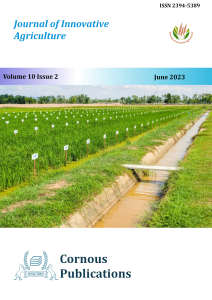
Journal of Innovative Agriculture
Peer Reviewed Open Access Journal
ISSN: 2394-5389 NAAS Rate: 4.05
Submit Manuscript
Peer Reviewed Open Access Journal
ISSN: 2394-5389 NAAS Rate: 4.05
Submit ManuscriptCluster-based large-scale demonstration of improved sorghum technology through irrigation was done with the objective of demonstrating and popularizing improved sorghum technology in the Bena-Tsemay district of the South Omo zone. A total of 17 agro-pastoralists participated in the demonstration, and one pastoral and agro-pastoral research and extension group containing 27 members was established. The demonstration took place on a 10-hectare plot of land in a cluster-based. Participatory training was given to all participants on important agronomic practices and management measures. Researchers applied all the recommended agronomic and management practices with close supervision and follow-up. Both qualitative data like agro-pastoral perception and agronomic data, and quantitative data like grain yield were collected and analyzed. Cost-benefit ratio was also calculated to see the economic feasibility of sorghum production. The result indicated that the mean grain yield of sorghum production was 2.65 tons per hectare and the net gain (profit) from sorghum production was 55975 Birr per hectare which is an initiative for producers to continue the production. Also, the benefit–cost ratio of 1.6:1 indicates that sorghum production is an economically feasible activity in the area. Pastoral perception and feedback were also collected from participants. Most participants indicated the sorghum (Melkam) variety performed better than their local in terms of yield, early maturity, disease resistance, seed color, and seed size. Thus, further expansion and seed supply by district and zone stakeholder groups to that area is necessary to enhance sorghum productivity and thereby ensuring food security.
cluster, demonstration, cost-benefit, production, sorghum, yield, Ethiopia
Abady, S., Liku, G., & Yadeta, D. (2017). Participatory varietal selection and evaluation of twelve sorghum (Sorghum bicolor (L.) Moench) varieties for lowlands of Eastern Hararghe. International Journal of Plant Breeding and Crop Science, 4(3), 281-285.
Adicha, A., Darcho, D., Ermias, G., & Kusse, K. (2022). Assessment of possibilities to establish model agricultural technology village in Southern Ethiopia. Journal of Innovative Agriculture, 9(1), 49-61.
Ali, M. A., Niaz, S., Abbas, A., Sabir, W., & Jabran, K. (2009). Genetic diversity and assessment of drought tolerant sorghum landraces based on morph-physiological traits at different growth stages. Plant Omics, 2(5), 214-227.
Araro, K., Legesse, S. A., & Meshesha, D. T. (2020). Climate change and variability impacts on rural livelihoods and adaptation strategies in Southern Ethiopia. Earth Systems and Environment, 4(1), 15-26.
Assefa, B. T., Chamberlin, J., Van Ittersum, M. K., & Reidsma, P. (2021). Usage and impacts of technologies and management practices in Ethiopian smallholder maize production. Agriculture, 11(10), 938.
Brhane, G., Belay, F., Gebreselassie, T., & Desta, D. (2019). Enhancing sorghum yield through demonstration of improved sorghum varieties in Tanqua-Abergelle Wereda, Central Zone of Tigray, Ethiopia. Journal of Agricultural Extension and Rural Development, 11(1), 11-16.
Central Statistical Agency (CSA). (2018). Agricultural sample survey 2017/2018: Report on area and productions of major crops (Vols. I, VII, & VIII, Statistical Bulletin No. 586). Central Statistical Agency.
Ethiopian Institute of Agricultural Research. (2016). Cereal crop production and management manual. EIAR.
Habte, A., Worku, W., Gayler, S., Ayalew, D., & Mamo, G. (2020). Model-based yield gap analysis and constraints of rainfed sorghum production in Southwest Ethiopia. The Journal of Agricultural Science, 158(10), 855-869.
Hemacho, A. H., Adicha, A., & Haile, S. T. (2016). Economic analysis of the effect of nitrogen and phosphorous fertilizer application for sorghum production at Alduba, South Omo, South Western Ethiopia. International Journal of Agricultural Economics, 1(2), 26–30.
Jarvis, A., Ramirez-Villegas, J., Herrera Campo, B. V., & Navarro-Racines, C. (2012). Is cassava the answer to African climate change adaptation? Tropical Plant Biology, 5(1), 9-29.
Kinfe, H., & Tesfaye, A. (2018). Yield performance and adoption of released sorghum varieties in Ethiopia. Edelweiss Applied Science and Technology, 2(1), 46-55.
Kusse, K., Ermias, G., Darcho, D. (2021). Major Cereal Crops Productions in South Omo Zone, Southern Ethiopia. Journal of Geography & Natural Disaster, 11(1), 493.
Mahdi, A. F., Zin, M. Z. M., Nor, M. R. M., Sakat, A. A., & Naim, A. S. A. (2012). The relationship between job satisfaction and turnover intention. American Journal of Applied Sciences, 9(9), 1518–1526.
Solomon, H., Miruts, F., Seyoum, A., & Endalamaw, C. (2021). Promotion of improved sorghum technologies through large-scale demonstration in Gololcha Woreda, Arsi Zone of Oromia Regional State, Ethiopia. American Journal of Plant Sciences, 12(3), 366-375.
